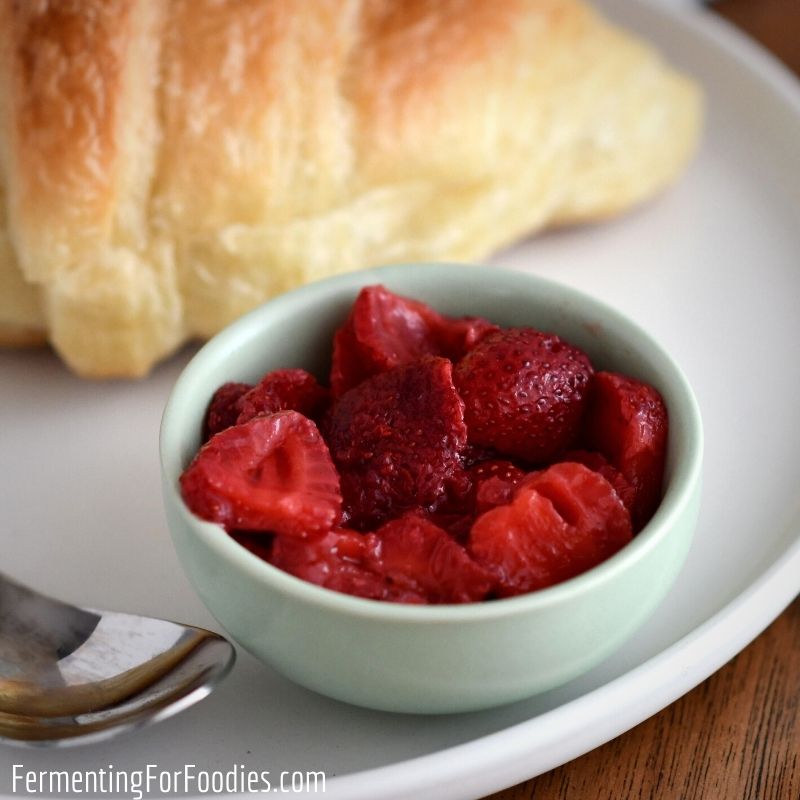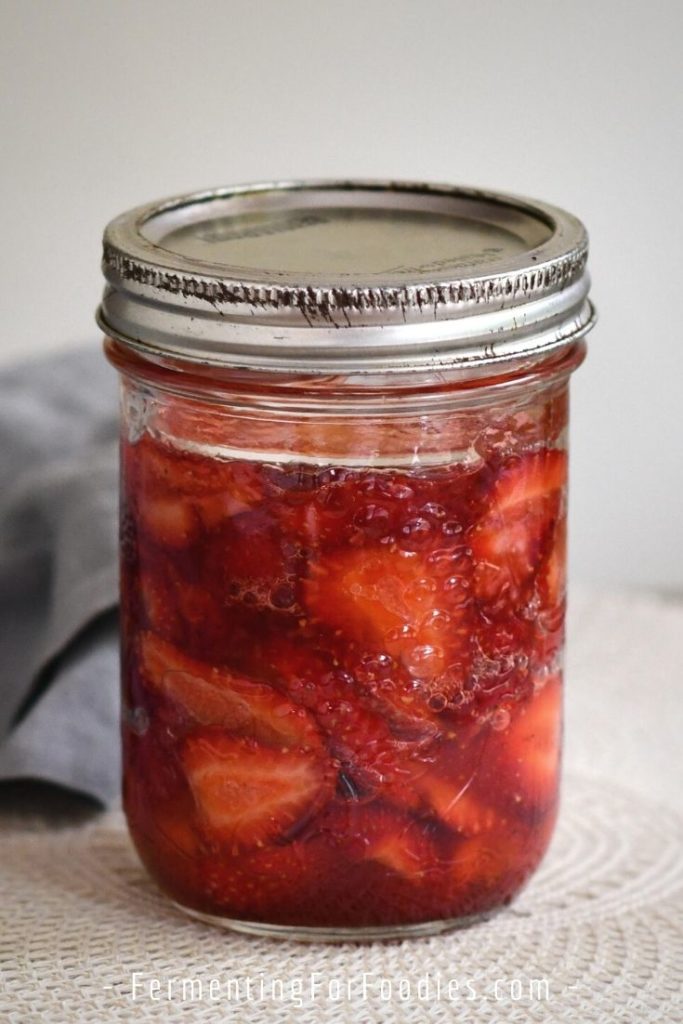Fermented strawberries are sweet, sparkling, and delicious. They are perfect as a pretty and probiotic topping for ice cream, waffles, or stirred into yogurt.

Here are a few reasons why you should consider fermenting strawberries:
- It’s an easy way to preserve a large crop of strawberries. Slice them up, stir in some culture and you’re done!
- Fermented strawberries can be used in so many different ways. Pureed into a thin sauce or a thick jam. Leave the fruit whole for a beautiful strawberry topping.
- If you ferment in straight-sided mason jars, they can be frozen right after fermenting so you can enjoy the flavor of spring all year long.
- It’s healthy, probiotic and low-sugar, vegan, gluten-free and delicious!
How to Make Strawberry Topping, Cordial or Jam
It’s really easy to take this simple fermented strawberry recipe and turn it into a sauce, cordial, or jam.
1. Strawberry Topping
A chunky strawberry topping is perfect on cheesecake, ice cream, or waffles. It’s also pretty delicious stirred into yogurt or served with a scone.
To make a strawberry topping, simply strain out the liquid when you serve the strawberries. Be sure to reserve the liquid for strawberry cordial!
2. Strawberry Cordial
Fermented strawberries usually end up with a lot of extra liquid. This rich-flavored liquid is perfect as a cordial. Use it like any other flavorful cordial. Serve it mixed with sparkling water or in a summery cocktail.
The only trick is that fermented strawberry cordial is not the same as a heavily sweetened strawberry syrup. I’m not really big into sweet flavors, so it’s perfect for me. However, if you’ve got a sweet tooth, feel free to add a bit of extra sweetener to your cordial.
3. Strawberry Jam
To turn fermented fruit into jam add a no-cook thickener. Jam is also typically sweeter than these fermented strawberries. While I enjoy low-free fruit treats, feel free to add sweeteners to suit your taste.
Here’s how to turn your strawberries into a thick and nutritious, no-cook, low-sugar jam.
- After fermenting, drain the excess liquid from the strawberries. (Reserve it for cordial!)
- Puree the strawberries with an immersion blender until you’ve reached the desired consistency. It can be chunky or smooth, it’s up to you.
- Taste the puree, and add a bit of sweetener, if you want. I recommend 1 Tbsp of honey or maple syrup per cup of strawberries. But adjust to suit your taste.
- Stir in 1 Tbsp of ground chia seeds per cup of strawberry puree. You can also use ground flax seeds, but the texture won’t be as smooth.
- Store the jam in the fridge for at least 24 hours so the chia seeds can thicken the jam.
- The jam may be sparkling for the first few days, especially if you add extra sweetener. Don’t worry, that will calm down over time.

Culture for Fermented Strawberries
Most fruit will naturally ferment. All you need to do is add a bit of sugar and leave it out on the counter under a tea towel. Give it a good stir twice a day and the wild yeasts will ferment your fruit.
However, using a culture offers a few advantages over wild-fermentation:
- Ensures a quick ferment
- Adds flavor
- Reduces the risk of contamination by mold or kahm yeast
Strawberries (and other fruit) can be fermented with any yeast-based culture. They are naturally sweet, so you only have to add a bit of sugar to feed the ferment.
Here are a few culture options. I’ve tried all of them, with good success.
- Ginger bug gives the strawberries a subtle gingery flavor. Use 4 Tbsp of ginger bug starter and don’t add any extra water. (My favorite as I love the gingery flavor).
- Kombucha tea and raw apple cider vinegar add a bit of tanginess to the strawberries. Use only 2 Tbsp of kombucha or vinegar.
- Unpasteurized honey will naturally ferment the strawberries. The natural yeasts are so vigorous that the resulting berries will be far less sweet than you expect. To make honey fermented strawberries, don’t add any sugar and stir in 2 Tbsp of honey instead. (My kids’ favorite). Honey is also the best option for long-term storage without freezing.
- Milk kefir whey and water kefir will also work as a yeast-based culture. Use 2 Tbsp of culture to ferment the strawberries.
Fermented Strawberries
Fermented strawberries are an easy way to preserve this delicious spring fruit. See the sections above for information on how to turn your strawberries into a probiotic topping, cordial, or jam.
- Prep Time: 10 minutes
- Total Time: 10 minutes
- Yield: 2 cups 1x
- Category: Fruit
- Method: Fermented
- Diet: Gluten Free
Ingredients
- 1 pint of strawberries (about 2 cups sliced)
- 1 to 4 Tbsp of culture (see section above for options)
- 1 Tbsp of sugar (optional)
- 2 Tbsp of water (chlorine-free)
Instructions
- Wash and slice the strawberries. Pack the berries into a pint-sized (500 mL) jar.
- Stir in the culture. See the section above for five different options. The amount of culture and the flavor of the ferment will depend on the type of culture you choose to use.
- Stir in 1 Tbsp of sugar, if using. This is a sweet ferment, so adding extra sugar will cause the strawberries to ferment more quickly and won’t necessarily impact the amount of sugar after fermenting.
- Add enough water to cover the strawberries. Use a weight to keep them from floating. Cover with a cloth or a fermentation-specific lid (see notes). Leave the jar to ferment in a dark location at room temperature for 2 to 4 days. A kitchen cupboard is ideal.
- The strawberries are finished when they have softened and the liquid is slightly sparkly. They will become less sweet and more sour the longer they ferment. If you ferment for longer than a week, expect them to taste quite tart. To stop the fermentation, cap the jar with an air-tight lid and store it in the fridge.
- Fermented strawberries taste best if enjoyed within 3 weeks. Otherwise, freeze them in straight-sided mason jars for long-term storage. See the section above for turning the strawberries into a topping, jam, or cordial.
Notes
- Don’t use strawberries that have started to go off. Always use freshly picked berries. You don’t want to accidentally contaminate your ferment with mold.
- This ferment will bubble, so it’s important to use a lid that will allow gas to escape. Using a mason jar lid that isn’t fully tightened works well. You can also use a Fido jar.



do you know if you can ferment strawberries with hot peppers. I am thinking about adding mangoes, ginger root and a little cultured vinegar.
You can definitely add any flavours you want! Cultured ACV is great at fermenting pretty much anything. Mangoes are quite sweet, so you can probably skip the sugar. Otherwise, I recommend it to feed the ACV mother. Enjoy!
Can I use defrosted strawberries?
I haven’t tried using frozen fruit, but as long as you have an active culture it should work!
I love fermenting things, but hadn’t tried fermenting strawberries. These are wonderful with a bit of plain yogurt plus, it doubles up on the ferments!
Sounds yum!
Hi! Can i drink the liquid as like a sort of kefir if i make it with water kefir and then eat the strawberries?
Yes! I often just mix the liquid with sparkling water for a cordial. It’s SOOOO yummmy. Enjoy!
Could the salt and water brine from fermented blueberries be used as the starter? I have fermented blueberries on but none of the other starters you mentioned.
Yes! I chose to write this as a sweet ferment because it’s quite typical with fruit flavors. But you could certainly do it as a salty ferment. Enjoy!
Hi, this is my first time preserving strawberries this way. I am wondering how long will the jam keep?
I recommend storing it in the fridge otherwise you’ll end up with a very sour jam as it will keep fermenting until all the sugars are gone. Once it’s in the fridge it should last for several months. I’ve actually never had a ferment go off in the fridge. Just be sure to use a clean spoon or knife to prevent contamination. Enjoy!